Cover
Title page
Introduction
Notice to users
Laws and regulations
Copyrights
Updating of IEEE documents
Errata
Interpretations
Patents
Participants
Historical participants
Contents
Figures
Tables
Important notice
1. Overview
1.1 Scope
1.2 Purpose
1.3 Introduction
1.4 VLAN aims and benefits
2. Normative references
3. Definitions
4. Abbreviations
5. Conformance
5.1 Requirements terminology
5.2 Conformant components and equipment
5.3 Protocol Implementation Conformance Statement (PICS)
5.4 VLAN-aware Bridge component requirements
5.5 C-VLAN component conformance
5.6 S-VLAN component conformance
5.7 I-component conformance
5.8 B-component conformance
5.9 VLAN Bridge conformance
5.10 Provider Bridge conformance
5.11 Backbone Edge Bridge conformance
5.12 VLAN-unaware Bridge component requirements
5.13 TPMR component conformance
5.14 TPMR conformance
5.15 T-component conformance
5.16 End station requirements for MMRP, MVRP, and MSRP
5.17 VLAN-aware end station requirements for Connectivity Fault Management
5.18 End station requirements—forwarding and queuing for time-sensitive streams
5.19 End station requirements for congestion notification
5.20 MAC-specific bridging methods
6. Support of the MAC Service
6.1 Basic architectural concepts and terms
6.2 Provision of the MAC service
6.3 Support of the MAC service
6.4 Preservation of the MAC service
6.5 Quality of service maintenance
6.6 Internal Sublayer Service
6.7 Support of the Internal Sublayer Service by specific MAC procedures
6.8 Enhanced Internal Sublayer Service
6.9 Support of the EISS
6.10 Support of the ISS/EISS by Provider Instance Ports
6.11 Support of the EISS by Customer Backbone Ports
6.12 Protocol VLAN classification
6.13 Support of the ISS for attachment to a Provider Bridged Network
6.14 Support of the ISS within a system
6.15 Support of the ISS by additional technologies
6.16 Filtering services in Bridged Local Area Networks
6.17 EISS Multiplex Entity
6.18 Backbone Service Instance Multiplex Entity
6.19 TESI Multiplex Entity
6.20 Support of the ISS with signaled priority
7. Principles of network operation
7.1 Network overview
7.2 Use of VLANs
7.3 VLAN topology
7.4 Locating end stations
7.5 Ingress, forwarding, and egress rules
8. Principles of bridge operation
8.1 Bridge operation
8.2 Bridge architecture
8.3 Model of operation
8.4 Active topologies, learning, and forwarding
8.5 Bridge Port Transmit and Receive
8.6 The Forwarding Process
8.7 The Learning Process
8.8 The Filtering Database
8.9 MST and ESP configuration information
8.10 Spanning Tree Protocol Entity
8.11 MRP Entities
8.12 Bridge Management Entity
8.13 Addressing
9. Tagged frame format
9.1 Purpose of tagging
9.2 Representation and encoding of tag fields
9.3 Tag format
9.4 Tag Protocol Identifier (TPID) formats
9.5 Tag Protocol Identification
9.6 VLAN Tag Control Information
9.7 Backbone Service Instance Tag Control Information
10. Multiple Registration Protocol (MRP) and Multiple MAC Registration Protocol (MMRP)
10.1 MRP overview
10.2 MRP architecture
10.3 MRP Attribute Propagation (MAP)
10.4 Requirements to be met by MRP
10.5 Requirements for interoperability between MRP Participants
10.6 Protocol operation
10.7 Protocol specification
10.8 Structure and encoding of MRP Protocol Data Units
10.9 Multiple MAC Registration Protocol (MMRP)—Purpose
10.10 Model of operation
10.11 Default Group filtering behavior and MMRP propagation
10.12 Definition of the MMRP application
11. VLAN topology management
11.1 Static and dynamic VLAN configuration
11.2 Multiple VLAN Registration Protocol
12. Bridge management
12.1 Management functions
12.2 VLAN-aware bridge objects
12.3 Data types
12.4 Bridge Management Entity
12.5 MAC entities
12.6 Forwarding process
12.7 Filtering Database
12.8 Bridge Protocol Entity
12.9 MRP Entities
12.10 Bridge VLAN managed objects
12.11 MMRP entities
12.12 MST configuration entities
12.13 Provider Bridge management
12.14 CFM entities
12.15 Backbone Core Bridge management
12.16 Backbone Edge Bridge management
12.17 DDCFM entities
12.18 PBB-TE Protection Switching managed objects
12.19 TPMR managed objects
12.20 Management entities for forwarding and queueing for time-sensitive streams
12.21 Congestion notification managed objects
12.22 SRP entities
13. Spanning Tree Protocols
13.1 Protocol design requirements
13.2 Protocol support requirements
13.3 Protocol design goals
13.4 RSTP overview
13.5 MSTP overview
13.6 Compatibility and interoperability
13.7 MST Configuration Identifier
13.8 Spanning Tree Priority Vectors
13.9 CIST Priority Vector calculations
13.10 MST Priority Vector calculations
13.11 Port Role assignments
13.12 Stable connectivity
13.13 Communicating Spanning Tree information
13.14 Changing Spanning Tree information
13.15 Changing Port States with RSTP or MSTP
13.16 Managing spanning tree topologies
13.17 Updating learned station location information
13.18 Managing reconfiguration
13.19 Partial and disputed connectivity
13.20 In-service upgrades
13.21 Fragile bridges
13.22 Spanning tree protocol state machines
13.23 State machine timers
13.24 Per bridge variables
13.25 Per port variables
13.26 State machine conditions and parameters
13.27 State machine procedures
13.28 The Port Timers state machine
13.29 Port Receive state machine
13.30 Port Protocol Migration state machine
13.31 Bridge Detection state machine
13.32 Port Transmit state machine
13.33 Port Information state machine
13.34 Port Role Selection state machine
13.35 Port Role Transitions state machine
13.36 Port State Transition state machine
13.37 Topology Change state machine
13.38 Layer 2 Gateway Port Receive state machine
13.39 Customer Edge Port Spanning Tree operation
13.40 Virtual Instance Port Spanning Tree operation
14. Use of BPDUs by MSTP
14.1 BPDU Structure
14.2 Encoding of parameter types
14.3 BPDU formats and parameters
14.4 Validation of received BPDUs
14.5 Transmission of BPDUs
14.6 Encoding and decoding of STP Configuration, RST, and MST BPDUs
15. Support of the MAC Service by Provider Bridged Networks
15.1 Service transparency
15.2 Customer service interfaces
15.3 Port-based service interface
15.4 C-tagged service interface
15.5 S-tagged service interface
15.6 Service instance segregation
15.7 Service instance selection and identification
15.8 Service priority selection
15.9 Service access protection
15.10 Connectivity Fault Management
15.11 Data-driven and data-dependent connectivity fault management (DDCFM)
16. Principles of Provider Bridged Network operation
16.1 Provider Bridged Network overview
16.2 Provider Bridged Network
16.3 Service instance connectivity
16.4 Service provider learning of customer end station addresses
16.5 Detection of connectivity loops through attached networks
16.6 Network management
17. Management Information Base (MIB)
17.1 Internet Standard Management Framework
17.2 Structure of the MIB
17.3 Relationship to other MIBs
17.4 Security considerations
17.5 Dynamic component and Port creation
17.6 MIB operations for service interface configuration
17.7 MIB modules
18. Principles of Connectivity Fault Management operation
18.1 Maintenance Domains and Domain Service Access Points
18.2 Service instances and Maintenance Associations
18.3 Maintenance Domain Levels
19. Connectivity Fault Management Entity operation
19.1 Maintenance Points
19.2 Maintenance association End Point
19.3 MIP Half Function
19.4 Maintenance Point addressing
19.5 Linktrace Output Multiplexer
19.6 Linktrace Responder
20. Connectivity Fault Management protocols
20.1 Continuity Check protocol
20.2 Loopback protocol
20.3 Linktrace protocol
20.4 Connectivity Fault Management state machines
20.5 CFM state machine timers
20.6 CFM procedures
20.7 Maintenance Domain variable
20.8 Maintenance Association variables
20.9 MEP variables
20.10 MEP Continuity Check Initiator variables
20.11 MEP Continuity Check Initiator procedures
20.12 MEP Continuity Check Initiator state machine
20.13 MHF Continuity Check Receiver variables
20.14 MHF Continuity Check Receiver procedures
20.15 MHF Continuity Check Receiver state machine
20.16 MEP Continuity Check Receiver variables
20.17 MEP Continuity Check Receiver procedures
20.18 MEP Continuity Check Receiver state machine
20.19 Remote MEP variables
20.20 Remote MEP state machine
20.21 Remote MEP Error variables
20.22 Remote MEP Error state machine
20.23 MEP Cross Connect variables
20.24 MEP Cross Connect state machine
20.25 MEP Mismatch variables
20.26 MEP Mismatch state machines
20.27 MP Loopback Responder variables
20.28 MP Loopback Responder procedures
20.29 MP Loopback Responder state machine
20.30 MEP Loopback Initiator variables
20.31 MEP Loopback Initiator transmit procedures
20.32 MEP Loopback Initiator transmit state machine
20.33 MEP Loopback Initiator receive procedures
20.34 MEP Loopback Initiator receive state machine
20.35 MEP Fault Notification Generator variables
20.36 MEP Fault Notification Generator procedures
20.37 MEP Fault Notification Generator state machine
20.38 MEP Mismatch Fault Notification Generator variables
20.39 MEP Mismatch Fault Notification Generator procedures
20.40 MEP Mismatch Fault Notification Generator state machine
20.41 MEP Linktrace Initiator variables
20.42 MEP Linktrace Initiator procedures
20.43 MEP Linktrace Initiator receive variables
20.44 MEP Linktrace Initiator receive procedures
20.45 MEP Linktrace Initiator receive state machine
20.46 Linktrace Responder variables
20.47 LTM Receiver procedures
20.48 LTM Receiver state machine
20.49 LTR Transmitter procedure
20.50 LTR Transmitter state machine
20.51 CFM PDU validation and versioning
20.52 PDU identification
20.53 Use of transaction IDs and sequence numbers
21. Encoding of CFM Protocol Data Units
21.1 Structure, representation, and encoding
21.2 CFM encapsulation
21.3 CFM request and indication parameters
21.4 Common CFM Header
21.5 TLV Format
21.6 Continuity Check Message format
21.7 Loopback Message and Loopback Reply formats
21.8 Linktrace Message Format
21.9 Linktrace Reply Format
22. Connectivity Fault Management in systems
22.1 CFM shims in Bridges
22.2 Maintenance Entity creation
22.3 MPs, Ports, and MD Level assignment
22.4 Stations and Connectivity Fault Management
22.5 Scalability of Connectivity Fault Management
22.6 CFM in Provider Bridges
22.7 Management Port MEPs and CFM in the enterprise environment
22.8 Implementing CFM on existing Bridges
23. MAC status propagation
23.1 Model of operation
23.2 MAC status protocol (MSP) overview
23.3 MAC status protocol state machines
23.4 State machine timers
23.5 MSP performance parameters
23.6 State machine variables
23.7 State machine procedures
23.8 Status Transition state machine
23.9 Status Notification state machine
23.10 Receive Process
23.11 Transmit Process
23.12 Management of MSP
23.13 MSPDU transmission, addressing, and protocol identification
23.14 Representation and encoding of octets
23.15 MSPDU structure
23.16 Validation of received MSPDUs
23.17 Other MSP participants
24.
25. Support of the MAC Service by Provider Backbone Bridged Networks
25.1 Service transparency
25.2 Customer service interface
25.3 Port-based service interface
25.4 S-tagged service interface
25.5 I-tagged service interface
25.6 Service instance segregation
25.7 Service instance selection and identification
25.8 Service priority and drop eligibility selection
25.9 Service access protection
25.10 Support of the MAC Service by a PBB-TE Region
25.11 Transparent service interface
26. Principles of Provider Backbone Bridged Network operation
26.1 Provider Backbone Bridged Network overview
26.2 Provider Backbone Bridged Network example
26.3 Backbone VLAN connectivity
26.4 Backbone addressing
26.5 Detection of connectivity loops through attached networks
26.6 Scaling of Provider Backbone Bridges
26.7 Network Management
26.8 Connectivity Fault Management in Provider Backbone Bridges
26.9 Connectivity Fault Management in a PBB-TE Region
26.10 Protection switching for point-to-point TESIs
26.11 Mismatch defect
27.
28.
29. DDCFM operations and protocols
29.1 Principles of DDCFM operation
29.2 DDCFM Entity operation
29.3 DDCFM protocols
29.4 Encoding of DDCFM Protocol Data Units
30. Principles of congestion notification
30.1 Congestion notification design requirements
30.2 Quantized Congestion Notification protocol
30.3 Congestion Controlled Flow
30.4 Congestion Notification Priority Value
30.5 Congestion Notification Tag
30.6 Congestion Notification Domain
30.7 Multicast data
30.8 Congestion notification and additional tags
31. Congestion notification entity operation
31.1 Congestion aware Bridge Forwarding Process
31.2 Congestion aware end station functions
32. Congestion notification protocol
32.1 Congestion Notification Domain operations
32.2 CN component variables
32.3 Congestion notification per-CNPV variables
32.4 CND defense per-Port per-CNPV variables
32.5 Congestion Notification Domain defense procedures
32.6 Congestion Notification Domain defense state machine
32.7 Congestion notification protocol
32.8 Congestion Point variables
32.9 Congestion Point procedures
32.10 Reaction Point per-Port per-CNPV variables
32.11 Reaction Point group variables
32.12 Reaction Point timer
32.13 Reaction Point variables
32.14 Reaction Point procedures
32.15 RP rate control state machine
32.16 Congestion notification and encapsulation interworking function
33. Encoding of congestion notification Protocol Data Units
33.1 Structure, representation, and encoding
33.2 Congestion Notification Tag format
33.3 Congestion Notification Message
33.4 Congestion Notification Message PDU format
34. Forwarding and queuing for time-sensitive streams
34.1 Overview
34.2 Detection of SRP domains
34.3 The bandwidth availability parameters
34.4 Deriving actual bandwidth requirements from the size of the MSDU
34.5 Mapping priorities to traffic classes for time-sensitive streams
34.6 End station behavior
35. Stream Registration Protocol (SRP)
35.1 Multiple Stream Registration Protocol (MSRP)
35.2 Definition of the MSRP application
Annex A (normative) PICS proforma—Bridge implementations
Annex B (normative) PICS proforma—End station implementations
Annex C (normative) DMN (Designated MSRP Node) Implementations
Annex D (normative) IEEE 802.1 Organizationally Specific TLVs
Annex E (normative) Notational conventions used in state diagrams
Annex F (informative) Shared and Independent VLAN Learning
Annex G (informative) MAC method dependent aspects of VLAN support
Annex H (informative) Interoperability considerations
Annex I (informative) Priority and drop precedence
Annex J (informative) Connectivity Fault Management protocol design and use
Annex K (informative) TPMR use cases
Annex L (informative) Operation of the credit-based shaper algorithm
Annex M (informative) Bibliography
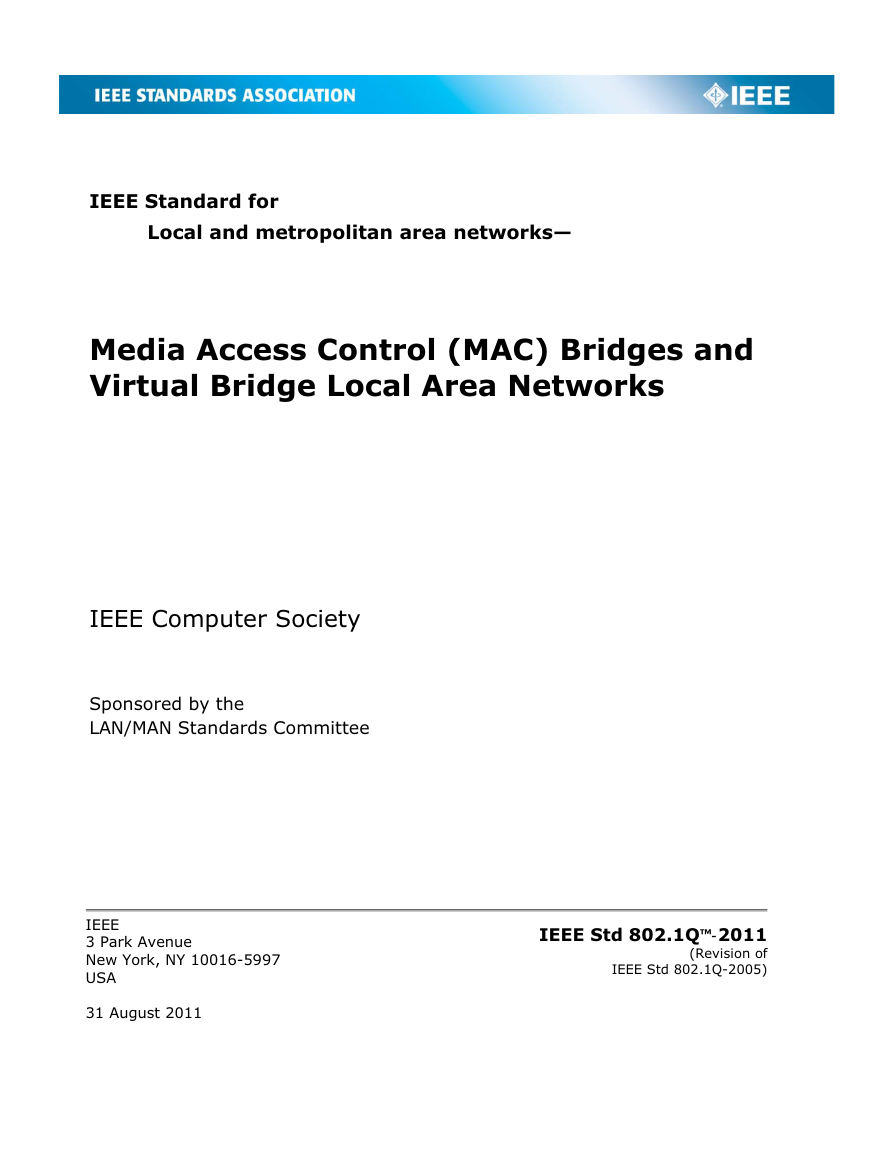


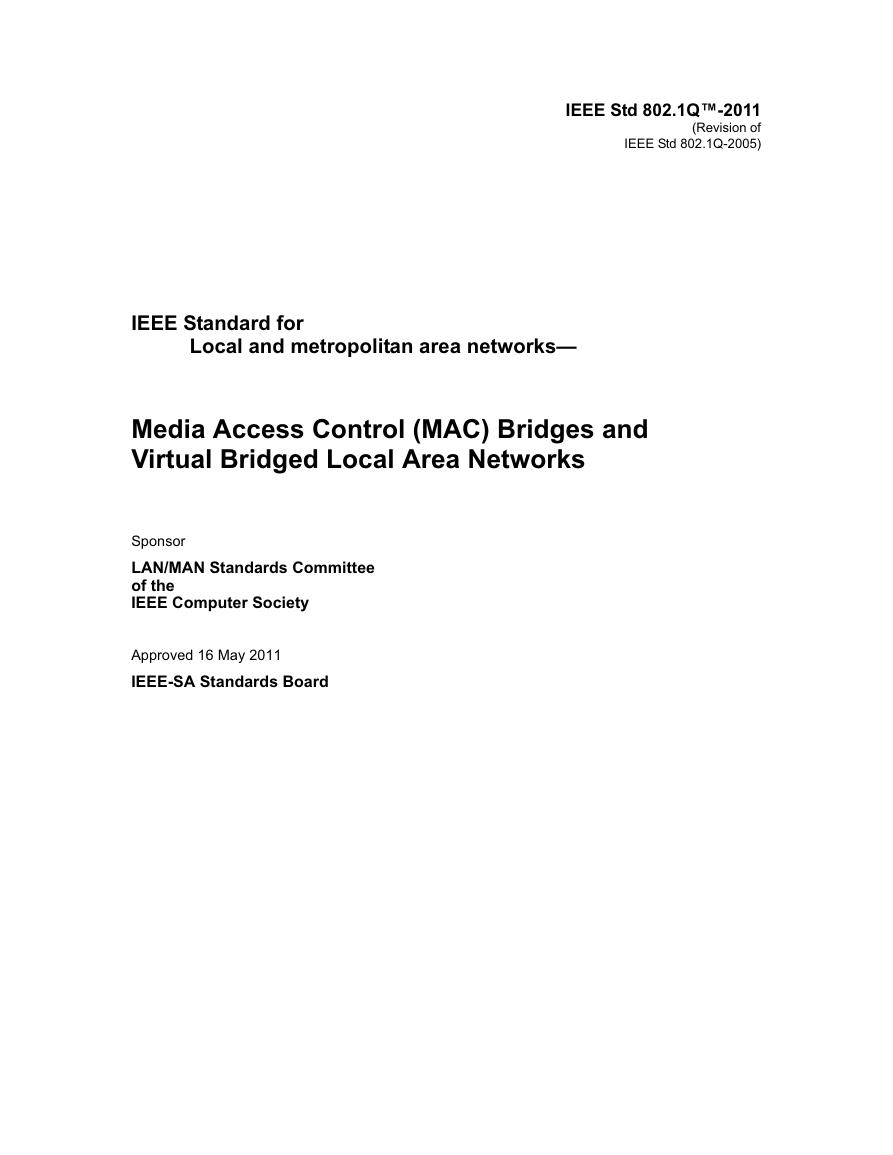
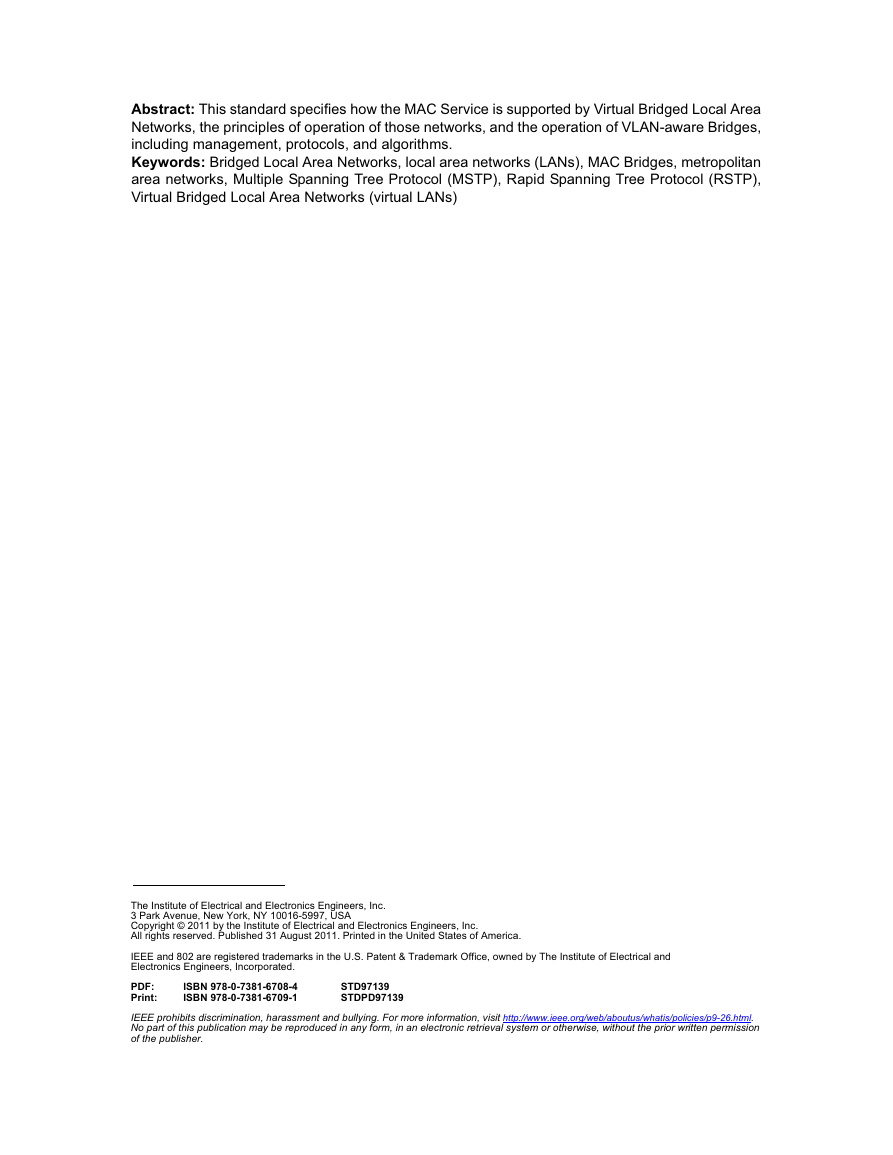
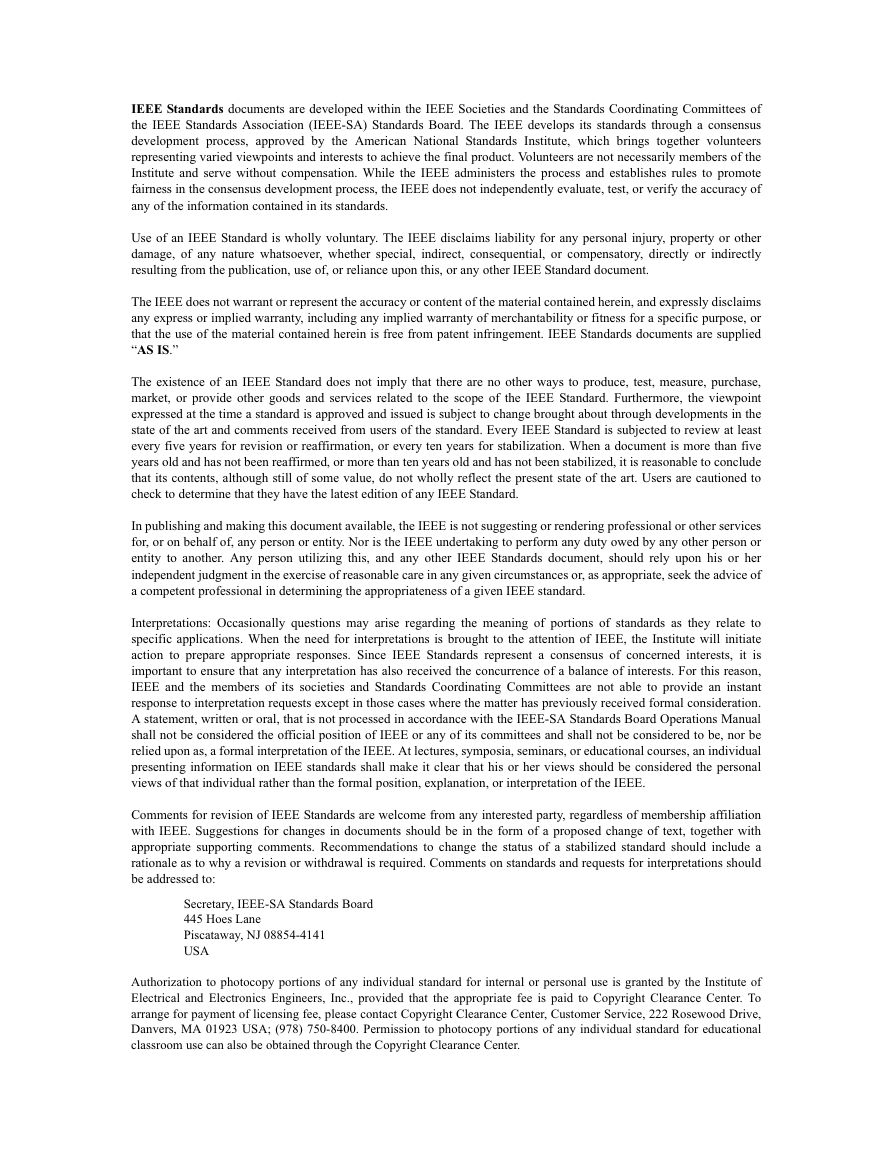
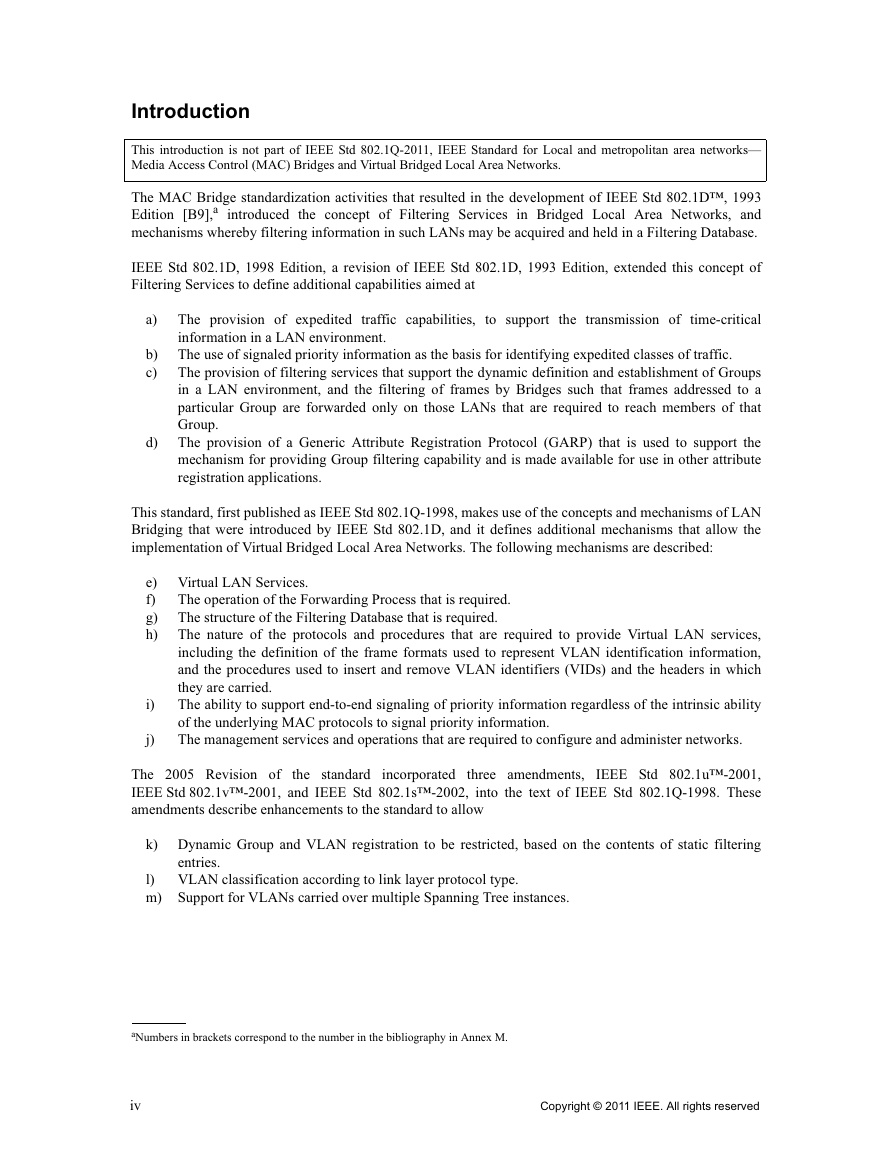
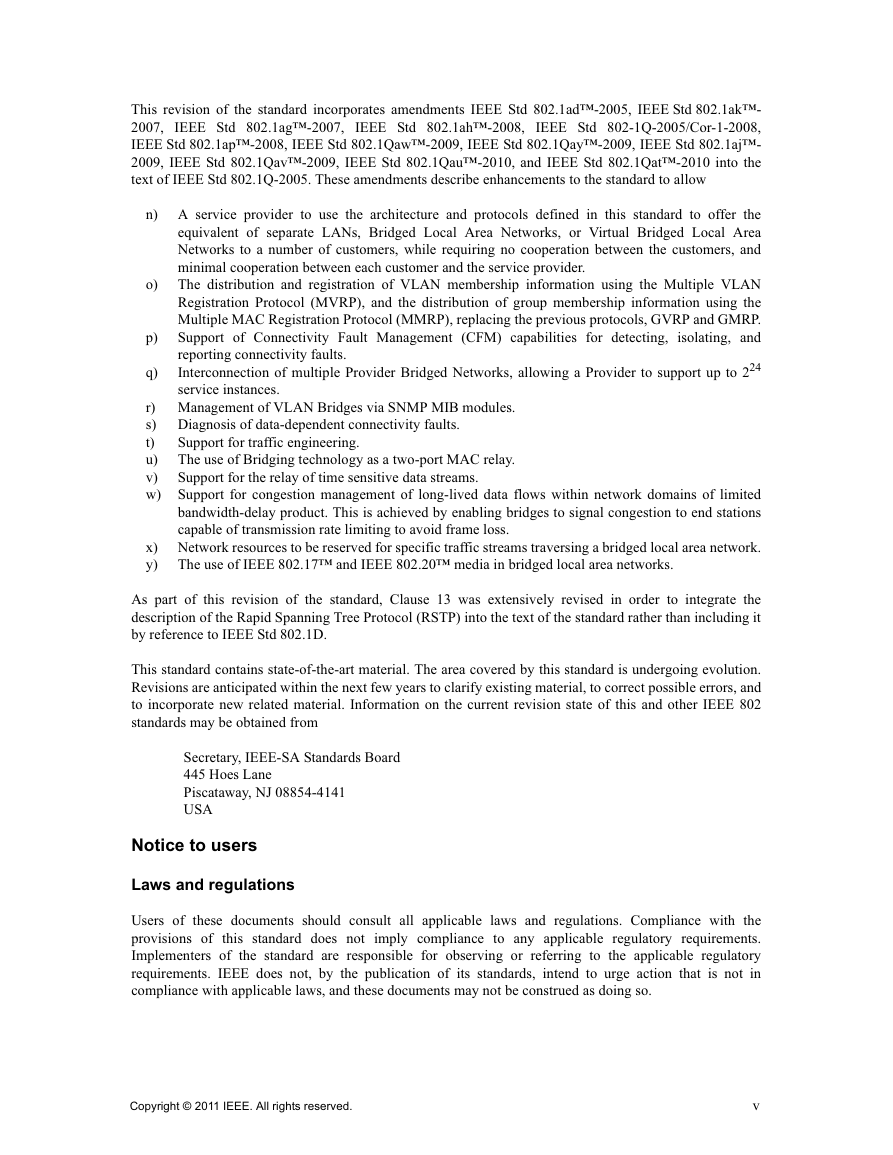








 2023年江西萍乡中考道德与法治真题及答案.doc
2023年江西萍乡中考道德与法治真题及答案.doc 2012年重庆南川中考生物真题及答案.doc
2012年重庆南川中考生物真题及答案.doc 2013年江西师范大学地理学综合及文艺理论基础考研真题.doc
2013年江西师范大学地理学综合及文艺理论基础考研真题.doc 2020年四川甘孜小升初语文真题及答案I卷.doc
2020年四川甘孜小升初语文真题及答案I卷.doc 2020年注册岩土工程师专业基础考试真题及答案.doc
2020年注册岩土工程师专业基础考试真题及答案.doc 2023-2024学年福建省厦门市九年级上学期数学月考试题及答案.doc
2023-2024学年福建省厦门市九年级上学期数学月考试题及答案.doc 2021-2022学年辽宁省沈阳市大东区九年级上学期语文期末试题及答案.doc
2021-2022学年辽宁省沈阳市大东区九年级上学期语文期末试题及答案.doc 2022-2023学年北京东城区初三第一学期物理期末试卷及答案.doc
2022-2023学年北京东城区初三第一学期物理期末试卷及答案.doc 2018上半年江西教师资格初中地理学科知识与教学能力真题及答案.doc
2018上半年江西教师资格初中地理学科知识与教学能力真题及答案.doc 2012年河北国家公务员申论考试真题及答案-省级.doc
2012年河北国家公务员申论考试真题及答案-省级.doc 2020-2021学年江苏省扬州市江都区邵樊片九年级上学期数学第一次质量检测试题及答案.doc
2020-2021学年江苏省扬州市江都区邵樊片九年级上学期数学第一次质量检测试题及答案.doc 2022下半年黑龙江教师资格证中学综合素质真题及答案.doc
2022下半年黑龙江教师资格证中学综合素质真题及答案.doc